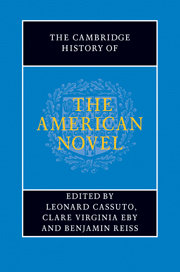Book contents
- Frontmatter
- General Introduction
- PART ONE INVENTING THE AMERICAN NOVEL
- PART TWO REALISM, PROTEST, ACCOMMODATION
- Introduction: realism, protest, accommodation
- 17 Realism and radicalism: the school of Howells
- 18 James, pragmatism, and the realist ideal
- 19 Theories of the American novel in the age of realism
- 20 The novel in postbellum print culture
- 21 Twain, class, and the Gilded Age
- 22 Dreiser and the city
- 23 Novels of civic protest
- 24 Novels of American business, industry, and consumerism
- 25 New Americans and the immigrant novel
- 26 Cather and the regional imagination
- 27 Wharton, marriage, and the New Woman
- 28 The postbellum race novel
- 29 The African American novel after Reconstruction
- 30 The rise of naturalism
- 31 Imagining the frontier
- 32 Imperialism, Orientalism, and empire
- 33 The hemispheric novel in the post-revolutionary era
- 34 The woman's novel beyond sentimentalism
- 35 Dime novels and the rise of mass-market genres
- 36 Readers and reading groups
- PART THREE MODERNISM AND BEYOND
- PART FOUR CONTEMPORARY FORMATIONS
- A selected bibliography
- Index
33 - The hemispheric novel in the post-revolutionary era
from PART TWO - REALISM, PROTEST, ACCOMMODATION
Published online by Cambridge University Press: 28 July 2011
- Frontmatter
- General Introduction
- PART ONE INVENTING THE AMERICAN NOVEL
- PART TWO REALISM, PROTEST, ACCOMMODATION
- Introduction: realism, protest, accommodation
- 17 Realism and radicalism: the school of Howells
- 18 James, pragmatism, and the realist ideal
- 19 Theories of the American novel in the age of realism
- 20 The novel in postbellum print culture
- 21 Twain, class, and the Gilded Age
- 22 Dreiser and the city
- 23 Novels of civic protest
- 24 Novels of American business, industry, and consumerism
- 25 New Americans and the immigrant novel
- 26 Cather and the regional imagination
- 27 Wharton, marriage, and the New Woman
- 28 The postbellum race novel
- 29 The African American novel after Reconstruction
- 30 The rise of naturalism
- 31 Imagining the frontier
- 32 Imperialism, Orientalism, and empire
- 33 The hemispheric novel in the post-revolutionary era
- 34 The woman's novel beyond sentimentalism
- 35 Dime novels and the rise of mass-market genres
- 36 Readers and reading groups
- PART THREE MODERNISM AND BEYOND
- PART FOUR CONTEMPORARY FORMATIONS
- A selected bibliography
- Index
Summary
During the first quarter of the nineteenth century, revolution swept much of the Western Hemisphere. By 1825, Brazil had freed itself from Portugal, and Spain had lost wars of independence to former colonies Argentina, Bolivia, Chile, Columbia, Guatemala, Ecuador, Mexico, and Peru. (Haiti had also liberated itself from France, but as the only independent black state in the New World, it had a more strained relationship to the shared revolutionary moment.) The revolutionaries leading these independence movements were, like the founders of the United States, influenced by European political philosophy and the Enlightenment, and their nationalisms can be viewed as part of a larger transnational liberal movement in Europe and America. Yet he spatial construct they more frequently employed to illustrate what had happened described a separation from Europe: the New World had radically broken ties with the Old to start over in a land naturally destined for democracy. In the Latin American republics, in remaining Spanish coloniessuch as Cuba, and in the United States, broad identification with the Western emisphere as a space of democratic difference from European monarchy became a key component of national mythologies expressed in cultural forms including poetry, painting, and the novel.
However, this utopian conception of hemispheric destiny existed alongside a number of factors dividing the Americas North and South. Religious and racial prejudices and intra- and international factions tied to particular economic interests such as plantation slavery, transatlantic trade, or agrarian territorial expansion all arrayed against the political idealism of hemispheric identification, offering competing geographies for the new republics.
- Type
- Chapter
- Information
- The Cambridge History of the American Novel , pp. 553 - 570Publisher: Cambridge University PressPrint publication year: 2011



